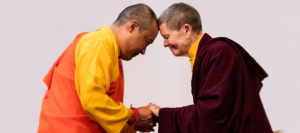
It can feel like a physical churning—an unquenchable thirst that manifests in our body as well as in our mind. We see something, we feel something, we think of something. We want that thing. It becomes the sole focus of our life and we feel that all energy must be channeled in that direction or else we might cease to exist.
Desire.
Unharnessed, it yields great dissatisfaction. Tamed and befriended, it becomes an ally to living a full life.
People often have an idea of Buddhist practitioners as austere beings who avoid any form of pleasure. Desire is denigrated as an obstacle on the path to enlightenment. Is there a place for desire to become an integral part of our Dharma path and not an obstruction?
I recently came across this quote from writer and musician Patti Smith: “Never let go of that fiery madness called desire.” I’m not able to find the source of this quote, and in most of the versions I saw online it goes like this: “Never let go of that fiery sadness called desire.” Still, I rather like “madness” and it lends itself to this piece, so I’m going with that wording for the purpose of this reflection.
How do we as Buddhists relate to desire? As I considered Patti’s quote, I shared it on my Substack with this thought: “I do actually believe this can coexist with a solid Buddhist practice. Some may disagree.” There were some interesting responses:
Desire for enlightenment or to help others yes. My desires for excitement, my past body and intoxicants—not so much I reckon. (Elly Marie)
Chogyam Trungpa certainly would agree. (Gregory Pettys)
I believe the Zen form of Buddhism calls us into a direct engagement with desire, a moving through with some entangling that is never completely loosened. It is the path of intimacy, after all. Guanyin’s way . . . (Rev. James Ford)
These responses capture some of the spectrum of the rich field of “desire” as a point of practice. The first commenter rightly notes that there are different kinds of desires, some of which fall more into the territory of addictions and others that are helpful when traveling on a path of awareness.
Those of us coming to Buddhism from other spiritual traditions tend to bring baggage along with us. I was steeped in Roman Catholicism that came with a heavy dose of shaming around desires, especially those wrapped up with sexuality and physicality. I still have some of that conditioned voice within me and, if I’m not awake to it, it can create suffering. When I first encountered Buddhism, that was my filter and I latched onto teachings related to renunciation. I thought the assignment was to obliterate desire. Little did I realize that this wasn’t a helpful approach. Life without desire is a pretty gray existence.
Another complicating factor is the limited nature of the English language. The Pali word tanha is often translated as desire, thirst, or craving. Tanha is viewed as the primary cause of duhkha, or dissatisfaction, as outlined in the First and Second Noble Truths. But there is more nuance to the concept than our rudimentary understanding of “desire.”
Desire may be categorized as either tanha or chanda. According to the late American philosopher Archie Bahm, taṇhā is “desiring more than will be attained,” whereas chanda is “desiring what, and no more than, will be attained.” (Bahm, pp. 24, 61) Ajahn Sucitto writes: “Desire as an eagerness to offer, to commit, to apply oneself to meditation, is called chanda. It’s a psychological ‘yes,’ a choice, not a pathology. In fact, you could summarize Dhamma training as the transformation of tanha into chanda.” (Kindle Location 935)
From a Buddhist perspective, the problem is not desire itself but rather the energy of attachment and clinging that often comes with it. When we find ourselves consumed by desire, we can take a step back and reflect on how we are relating to that sensation. Rev. James Ford’s quote points in that direction. The tantric practices of Tibetan Buddhism comprise a highly developed approach to relating to desire. Tibetan practitioner and author Miranda Shaw says: “The word tantra comes from the verbal stem tan meaning “to weave,” and tantra is a spiritual path that weaves, or integrates, every aspect of life, including all daily activities, intimacy and passion, into the path to enlightenment.” (Inquiring Mind)
The comment that referenced Chogyam Trungpa Rinpoche brings up yet another dimension of desire—the fundamental importance of rooting one’s choices and actions in sila, the precepts. Desire that is unmoored from ethics can quickly devolve into behaviors that cause harm to others as well as oneself.
Clearly there is no one standard way to think of, or relate to, desire. Like everything else, it is subject to an interrelated web of causes and conditions. But all of this leaves open the possibility for a kind of desire that can actually support our Dharma practice and our life.
One question that often helps me, not only with desire but with other choice points, is to consider whether something I am about to do is wholesome. That might feel like an old-fashioned word but I find it useful. Is this thing I am desiring something that will contribute to the well-being, both short- and long-term, of myself as well as others? If yes, it is wholesome, as in it lends itself toward the whole of our being, it aids in the process of bringing lost parts back into relationship and wholeness. If no, I have to ask why I would forge ahead and do it.
As a kind of exercise, I invite you to reflect on what you are desiring right now. Don’t censor anything—it can range from the trivial to the profound. My own list includes things such as: peach cobbler from the barbecue place around the corner from my house, a Netflix subscription so I can binge on Emily in Paris and The Great British Baking Show, clemency for Leonard Peltier, sustaining global peace.
Ask yourself what is wholesome on your list, what deserves your unreserved energy. When you identify the kinds of desires that may lead to wholesome outcomes, give yourself permission to follow them wholeheartedly, perhaps even with some of that madness that Patti Smith tagged.
My sense is that this kind of desire plays well with virya, one of the six Paramitas. In Sanskrit, virya is translated as energy, effort, and persistence. Our practice benefits when we infuse it with virya, with joyful effort. It is the fuel that gets us through long hours in the zendo, it is what helps us to withstand difficult episodes in our lives. In the coming times, as we face a volatile world where political upheaval and climate crisis are accelerating, this type of desire may be the medicine we need to persist in the bodhisattva work of serving and loving all beings.
There was one more comment in response to Patti Smith’s quote that I really appreciated and which sums up this kind of desire and how it intersects with our Dharma practice:
My whole life is about embodying such ferocity with calm. (Swarnali Mukherjee).
References
Bahm, Archie J. 1959 (reprint: 1993). Philosophy of the Buddha. Fremont, CA: Jain Publishing.
Sucitto, Ajahn. 2010. Turning the Wheel of Truth: Commentary on the Buddha’s First Teaching. Boulder, CO: Shambhala Publications.
See more
Interview with Miranda Shaw: Tantra—A Fully Embodied Path (Inquiring Mind)
Related features from BDG
The Most Wonderfully Stressful Time of the Year: Expectations and Consumerism During the Holiday Season
The Sober Path
Desire Causes Suffering
Bagels and Mooncakes—Dealing with Desire and Craving
What is your inmost desire?















I found this column very helpful. In conversation, I’ve noticed people often struggle with the concept of giving up their desires and it has been difficult for me to explain. Now, thanks to this column, I understand the difference between Tanha vs. Chanda and feel more confident in my ability to explain that difference to others. I am grateful to the author for doing the research and making the Dhamma accessible to us Westerners. – Thank you!
So glad you find this article useful, Edro. I certainly learned a lot while researching and writing it. Instinctively I felt there was a type of desire that was more wholesome, but I didn’t know about the distinction between tanha and chanda.